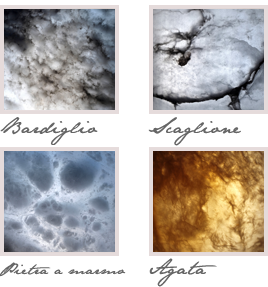© alab'Arte snc di R.Chiti e G.Finazzo - P.IVA 01383030507

Workshop: Via Orti di Sant'Agostino, 28 - Volterra
Shop: Via Don Minzoni, 18 - Volterra
From a chemical analysis alabaster is a simple salt; it is in fact calcium sulphate dihydrate and the molecular formula for alabaster is: CaSO4 2H2O. From a mineralogical standpoint alabaster is a microcrystalline variety of chalk: this means that the crystals that together form alabaster are so small that they cannot be seen with the naked eye, but only through lens of a microscope.

The microcrystals of chalk are iso-oriented and allow the transfer of light, thus giving alabaster the name of Stone of Light. Alabaster also has physical and mechanical properties that place it among other soft materials, registering 2°-3° on the Mohs' hardness scale. Together with its crystalline weave, this makes alabaster a stone that can be easily worked.
From a lithological point of view chalk is an "evaporite", which means that it is a sedimentary rock chemically deposited in marine environments with very high salt levels.
In fact, chalk separates itself from water when the salt level, which is usually around 35%, reaches a concentration of approximately 170/180 grams per liter.
Alabaster can be divided into these four main categories:
Alabaster is found in ovaloid blocks called arnioni (or "kidneys") that are encased in a matrix of clay and chalk. The arnione is extracted by freeing it from the rock"shell" that surrounds it, and, once completely cleaned, it is ready to be worked.
Being a delicate and relatively soft and porous stone, it should not be kept in direct contact with atmospheric conditions, nor too close to sources of heat (with regards to lamps, it is advisable use "cold" light bulbs).
Sculptures: After having delicately removed the dust with a soft dry brush, and only if should be absolutely necessary, wash with clean water or with water and a neutral soap and then let dry naturally.
Miscellaneous articles: Most articles, are normally already treated with oil and wax, they should be dusted with a slightly damp brush or cloth and then left to dry naturally. They can then be polished using oil of Vaseline or other neutral oil which should be applied with a brush. Once the oil has been absorbed, any excess can be removed with a soft cloth.